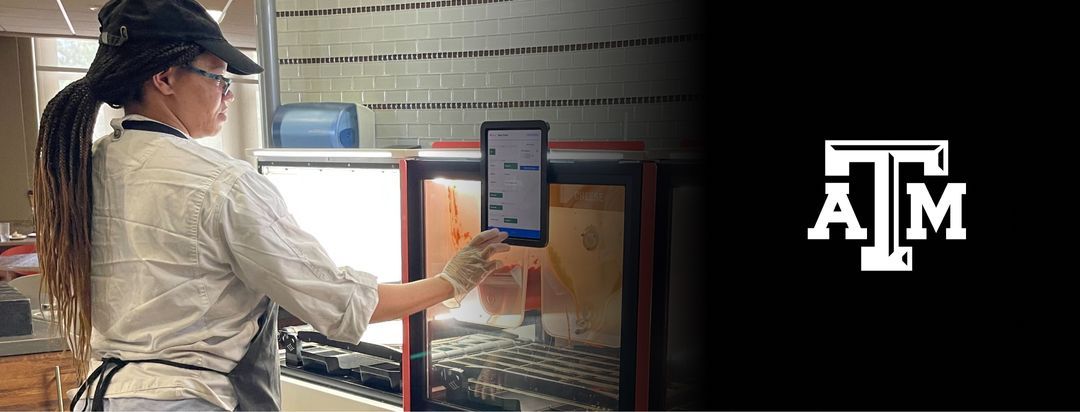How Texas A&M dining increased efficiency and student satisfaction with the Picnic Pizza Station

The Chartwells food service team at Texas A&M has been short staffed since Covid. As students returned to campus, they brought their appetites and a desire for life—and their campus food service—to get back to normal.
Chartwells’ district executive chef, Marc Cruz, was eager to offer his diners their old favorites, including freshly assembled pizza. But pizza is a labor-intensive dish to produce, and Cruz was unable to keep the makeline staffed week after week. At one point, when no other staff could come in, Cruz found himself alone in the kitchen making pizzas by hand.
Looking for solutions, Cruz considered bringing in frozen pizzas, eliminating the bulk of the labor. But working with his procurement manager, Andrew Greene,
he determined that not only would the quality be diminished, but the food costs would come in too high. Searching for solutions, Greene spoke to the team at Rich’s, who suggested that the Chartwells team check out the Picnic Pizza Station.
A pizza robot that promised up to 100 pies an hour with a significant reduction in food waste? Cruz was curious to see if food automation could help him make consistent pizzas and reallocate the staff he already had in place. And it didn’t hurt that Picnic CEO Clayton Wood is an Aggie, too, graduating from Texas A&M with Bachelor’s and Master’s degrees in mechanical engineering.
We've seen a significant increase in efficiency with the Picnic Pizza Station. We’ve freed up at least one full time employee in every shift to stop making pizzas and do other critical jobs around the kitchen.
Cruz, Greene, and the team at Picnic worked together to come up with a pilot plan. The goal was to deploy the Picnic Pizza Station as the Texas A&M students returned to campus for spring semester 2022. They tested ingredients, tasted pizzas, and trained staff to use the simple digital interface. The kitchen staff was making pizzas the same day the machine was installed, and within days, team members were expertly cross-training colleagues on how to use the station.
The Picnic Pizza Station was installed at Texas A&M’s Sbisa Dining Hall in full view of the student diners. As pizzas made by the Picnic Pizza Station were fed into the kitchen’s wood-fired oven, students lined up to watch the system and eat the pizza.
Within weeks, the Chartwells team was easily meeting diner demand, making more than 450 pizzas per week with the Picnic Pizza Station with just one operator. Chef Cruz was elated, noting “We’ve seen a significant increase
in efficiency with the Picnic Pizza Station. We’ve freed up at least one full time employee in every shift to stop making pizzas and do other critical jobs around the kitchen.”
The benefits didn’t stop at the reduction in pizza labor. The Chartwells team also appreciated the precision offered by the Picnic Pizza Station. With the exact metering offered by each topping module, every pizza was produced with a consistent amount of sauce, cheese, and pepperoni, conforming exactly to the Chartwells recipe, and lowering food costs.
Procurement manager Greene was thrilled with the promise of food cost savings. He wrote on LinkedIn:
If you didn’t think it could happen, it happened, this technology in my opinion makes pizza and cost control more fun than ever before!
With the Picnic Pizza Station in place, Cruz was able to move kitchen staff to other stations in the dining hall, increasing student meal choices and satisfaction and relieving team stress. But there was one more test: did the students notice a difference with an automated pizza assembly system?
On a bright February day, the Picnic team surveyed pizza-loving Aggies to see what they thought. In a blind test, students tasted and compared slices of pizza made by hand and made by the Picnic Pizza Station.
Overwhelmingly, tasters found they preferred the sauce and cheese spreading offered on the slices made by the station.
As one student wrote, “I liked the pizza overall. Compared to the last, it did much better in cheese distribution, cheese amount, pepperoni distribution, and pepperoni amount. It would rank higher on my first choices of pizza.”
Additionally, 80% of the students surveyed said they believe robotic technology helps make consistent pizzas and 88% noted that they are “interested in seeing the robot at work,” underscoring the “Wow” factor that the Picnic Pizza Station brings to food service.
Cruz, Greene, and the rest of the Chartwells team are pleased with the results of the pilot program and are working with the team at Picnic to deploy the Picnic Pizza Station to more campuses across the U.S. Starting in fall 2022, The Picnic Pizza Station will be deployed full time at Texas A&M University along with four more schools including the University of Chicago, Carroll University, Missouri State, and Indiana University – Purdue University Indianapolis.
A&M graduate and Picnic CEO Clayton Wood says,
“As a Texas Aggie, I couldn’t be prouder of the Picnic collaboration with Chartwells Higher Education Dining Services, bringing pizza automation to Texas A&M University. In a short time, we’ve made thousands of pizzas and the students love it. Win-Win!”